您好,登錄后才能下訂單哦!
您好,登錄后才能下訂單哦!
今天小編給大家分享一下QT基于TCP如何實現網絡聊天室程序的相關知識點,內容詳細,邏輯清晰,相信大部分人都還太了解這方面的知識,所以分享這篇文章給大家參考一下,希望大家閱讀完這篇文章后有所收獲,下面我們一起來了解一下吧。
TCP與UDP的差別如圖:

如下圖所示,TCP能夠為應用程序提供可靠的通信連接,使一臺計算機發出的字節流無差錯 地送達網絡上的其他計算機。因此,對可靠性要求高的數據通信系統往往使用TCP傳輸數據,但在正式收發數據前,通信雙方必須首先建立連接。

下面介紹基于TCP的經典編程模型,TCP客戶端與服務器間的交互時序如下圖所示:
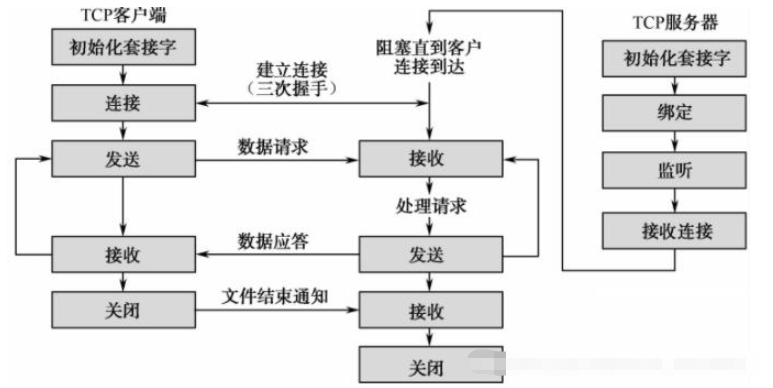
TCP服務器端的具體實現如下:
建立工程TcpServer.pro,文件代碼如下。
(1)頭文件“tcpserver.h”中聲明了需要的各種控件,TcpServer繼承自QDialog,實現了服務器端的對話框顯示與控制。其具體代碼如下:
#include <QDialog>
#include <QListWidget>
#include <QLabel>
#include <QLineEdit>
#include <QPushButton>
#include <QGridLayout>
class TcpServer : public QDialog
{
Q_OBJECT
public:
TcpServer(QWidget *parent = 0,Qt::WindowFlags f=0);
~TcpServer();
private:
QListWidget *ContentListWidget;
QLabel *PortLabel;
QLineEdit *PortLineEdit;
QPushButton *CreateBtn;
QGridLayout *mainLayout;
};(2)在源文件“tcpserver.cpp”中,TcpServer類的構造函數主要實現窗體各控件的創建、布局等,其具體代碼如下:
#include "tcpserver.h"
TcpServer::TcpServer(QWidget *parent,Qt::WindowFlags f) : QDialog(parent,f)
{
setWindowTitle(tr("TCP Server"));
ContentListWidget = new QListWidget;
PortLabel = new QLabel(tr("端口:"));
PortLineEdit = new QLineEdit;
CreateBtn = new QPushButton(tr("創建聊天室"));
mainLayout = new QGridLayout(this);
mainLayout->addWidget(ContentListWidget,0,0,1,2);
mainLayout->addWidget(PortLabel,1,0);
mainLayout->addWidget(PortLineEdit,1,1);
mainLayout->addWidget(CreateBtn,2,0,1,2);
}(3)服務器端界面如下圖所示:
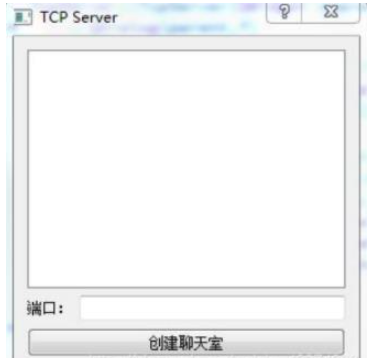
以上完成了服務器端界面的設計,下面將詳細完成聊天室的服務器端功能。
(1)在工程文件“TcpServer.pro”中添加如下語句:
QT += network
(2)在工程“TcpServer.pro”中添加C++類文件“tcpclientsocket.h”及“tcpclientsocket.cpp”,TcpClientSocket 繼承自QTcpSocket,創建一個TCP套接字,以便在服務器端實現與客戶端程序的通信。
頭文件“tcpclientsocket.h”的具體代碼如下:
#include <QTcpSocket>
#include <QObject>
class TcpClientSocket : public QTcpSocket
{
Q_OBJECT //添加宏(Q_OBJECT)是為了實現信號與槽的通信
public:
TcpClientSocket(QObject *parent=0);
signals:
void updateClients(QString,int);
void disconnected(int);
protected slots:
void dataReceived();
void slotDisconnected();
};(3)在源文件“tcpclientsocket.cpp”中,構造函數(TcpClientSocket)的內容(指定了信號與槽的
連接關系)如下:
#include "tcpclientsocket.h"
TcpClientSocket::TcpClientSocket(QObject *parent)
{
connect(this,SIGNAL(readyRead()),this,SLOT(dataReceived())); // readyRead()是QIODevice的signal,由 QTcpSocket繼承而來。QIODevice是所有輸入/輸出設備的一個抽象類,其中定義了基本的接口,在Qt中, QTcpSocket也被看成一個QIODevice,readyRead()信號在有數據到來時發出。
connect(this,SIGNAL(disconnected()),this,SLOT(slotDisconnected())); // disconnected()信號在斷開連接時發出。
}在源文件“tcpclientsocket.cpp”中,dataReceived()函數的具體代碼如下:
void TcpClientSocket::dataReceived()
{
while(bytesAvailable()>0)
{
int length = bytesAvailable();
char buf[1024];
read(buf,length);
QString msg=buf;
emit updateClients(msg,length);
}
}在源文件“tcpclientsocket.cpp”中,槽函數slotDisconnected()的具體代碼如下:
void TcpClientSocket::slotDisconnected()
{
emit disconnected(this->socketDescriptor());
}(4)在工程“TcpServer.pro”中添加C++類文件“server.h”及“server.cpp”,Server繼承自QTcpServer,實現一 個TCP協議的服務器。利用QTcpServer,開發者可以監聽到指定端口的TCP連接。其具體代碼如下:
#include <QTcpServer>
#include <QObject>
#include "tcpclientsocket.h" //包含TCP的套接字
class Server : public QTcpServer
{
Q_OBJECT
//添加宏(Q_OBJECT)是為了實現信號與槽的通信
public:
Server(QObject *parent=0,int port=0);
QList<TcpClientSocket*> tcpClientSocketList;
signals:
void updateServer(QString,int);
public slots:
void updateClients(QString,int);
void slotDisconnected(int);
protected:
void incomingConnection(int socketDescriptor);
};(5)在源文件“server.cpp”中,構造函數(Server)的具體內容如下:
#include "server.h"
Server::Server(QObject *parent,int port):QTcpServer(parent)
{
listen(QHostAddress::Any,port);
}其中,listen(QHostAddress::Any,port)在指定的端口對任意地址進行監聽。
QHostAddress定義了幾種特殊的IP地址,如QHostAddress::Null表示一個空地址;
QHostAddress::LocalHost表示IPv4的本機地址127.0.0.1;
QHostAddress::LocalHostIPv6表示IPv6的本機地址;
QHostAddress::Broadcast表示廣播地址255.255.255.255;
QHostAddress::Any表示IPv4的任意地址0.0.0.0;
QHostAddress::AnyIPv6表示IPv6的任意地址。
在源文件“server.cpp”中,當出現一個新的連接時,QTcpSever觸發incomingConnection()函數,參數
socketDescriptor指定了連接的Socket描述符,其具體代碼如下:
void Server::incomingConnection(int socketDescriptor)
{
TcpClientSocket *tcpClientSocket=new TcpClientSocket(this); //創建一個新的TcpClientSocket與客戶端通信。
connect(tcpClientSocket,SIGNAL(updateClients(QString,int), this,SLOT(updateClients(QString,int))); //連接TcpClientSocket的updateClients信號。
connect(tcpClientSocket,SIGNAL(disconnected(int)),this, SLOT(slotDisconnected(int))); //連接 TcpClientSocket的disconnected信號。
tcpClientSocket->setSocketDescriptor(socketDescriptor); //將新創建的TcpClient Socket的套接字描述符指定為參數socketDescriptor。
tcpClientSocketList.append(tcpClientSocket); //將tcpClientSocket加入客戶端套接字列表以便管理。
}在源文件“server.cpp”中,updateClients()函數將任意客戶端發來的信息進行廣播,保證聊天室的所有成員均能看到其他人的發言。其具體代碼如下:
void Server::updateClients(QString msg,int length)
{
emit updateServer(msg,length); //發出updateServer信號,用來通知服務器對話框更新相應的顯示狀態。
for(int i=0;i<tcpClientSocketList.count();i++) //實現信息的廣播,tcpClientSocketList中保存了所有與服務器相連的TcpClientSocket對象。
{
QTcpSocket *item = tcpClientSocketList.at(i);
if(item->write(msg.toLatin1(),length)!=length)
{
continue;
}
}
}在源文件“server.cpp”中,slotDisconnected()函數實現從tcpClientSocketList列表中將斷開連接的
TcpClientSocket對象刪除的功能。其具體代碼如下:
void Server::slotDisconnected(int descriptor)
{
for(int i=0;i<tcpClientSocketList.count();i++)
{
QTcpSocket *item = tcpClientSocketList.at(i);
if(item->socketDescriptor()==descriptor)
{
tcpClientSocketList.removeAt(i);
return;
}
}
return;
}(6)在頭文件“tcpserver.h”中添加如下內容:
#include "server.h" private: int port; Server *server; public slots: void slotCreateServer(); void updateServer(QString,int);
(7)在源文件“tcpserver.cpp”中,在構造函數中添加如下代碼:
port=8010; PortLineEdit->setText(QString::number(port)); connect(CreateBtn,SIGNAL(clicked()),this,SLOT(slotCreateServer()));
其中,槽函數slotCreateServer()用于創建一個TCP服務器,具體內容如下:
void TcpServer::slotCreateServer()
{
server = new Server(this,port); //創建一個Server對象
connect(server,SIGNAL(updateServer(QString,int)),this,
SLOT(updateServer(QString,int)));
CreateBtn->setEnabled(false);
}槽函數updateServer()用于更新服務器上的信息顯示,具體內容如下:
void TcpServer::updateServer(QString msg,int length)
{
ContentListWidget->addItem(msg.left(length));
}(8)此時,工程中添加了很多文件,工程文件中的內容已經被改變,需要重新在工程文件
“TcpServer.pro”中添加:
QT += network
此時,運行服務器端工程“TcpServer.pro”編譯通過。單擊“創建聊天室”按鈕,便開通了一個TCP聊天室的服務器,如下圖所示:
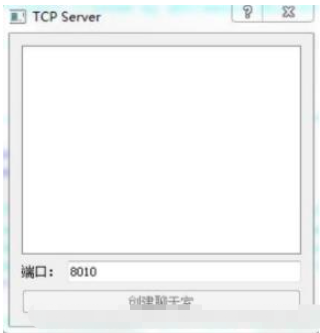
TCP客戶端編程具體步驟如下:
建立工程“TcpClient.pro”,文件代碼如下。
(1)在頭文件“tcpclient.h”中,TcpClient類繼承自QDialog類,聲明了需要的各種控件,其具體代碼如下:
#include <QDialog>
#include <QListWidget>
#include <QLineEdit>
#include <QPushButton>
#include <QLabel>
#include <QGridLayout>
class TcpClient : public QDialog
{
Q_OBJECT
public:
TcpClient(QWidget *parent = 0,Qt::WindowFlags f=0);
~TcpClient();
private:
QListWidget *contentListWidget;
QLineEdit *sendLineEdit;
QPushButton *sendBtn;
QLabel *userNameLabel;
QLineEdit *userNameLineEdit;
QLabel *serverIPLabel;
QLineEdit *serverIPLineEdit;
QLabel *portLabel;
QLineEdit *portLineEdit;
QPushButton *enterBtn;
QGridLayout *mainLayout;
};(2)源文件“tcpclient.cpp”的具體代碼如下:
#include "tcpclient.h"
TcpClient::TcpClient(QWidget *parent,Qt::WindowFlags f)
: QDialog(parent,f)
{
setWindowTitle(tr("TCP Client"));
contentListWidget = new QListWidget;
sendLineEdit = new QLineEdit;
sendBtn = new QPushButton(tr("發送"));
userNameLabel = new QLabel(tr("用戶名:"));
userNameLineEdit = new QLineEdit;
serverIPLabel = new QLabel(tr("服務器地址:"));
serverIPLineEdit = new QLineEdit;
portLabel = new QLabel(tr("端口:"));
portLineEdit = new QLineEdit;
enterBtn= new QPushButton(tr("進入聊天室"));
mainLayout = new QGridLayout(this);
mainLayout->addWidget(contentListWidget,0,0,1,2);
mainLayout->addWidget(sendLineEdit,1,0);
mainLayout->addWidget(sendBtn,1,1);
mainLayout->addWidget(userNameLabel,2,0);
mainLayout->addWidget(userNameLineEdit,2,1);
mainLayout->addWidget(serverIPLabel,3,0);
mainLayout->addWidget(serverIPLineEdit,3,1);
mainLayout->addWidget(portLabel,4,0);
mainLayout->addWidget(portLineEdit,4,1);
mainLayout->addWidget(enterBtn,5,0,1,2);
}(3)客戶端界面如下圖所示:
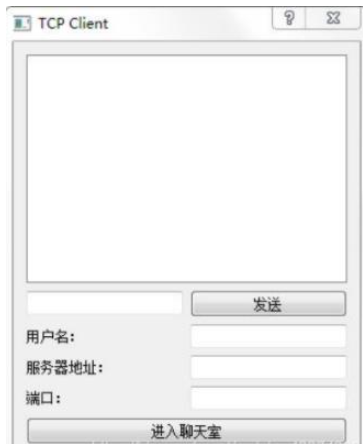
以上完成了客戶端界面的設計,下面將完成客戶端的真正聊天功能。
(1)在客戶端工程文件“TcpClient.pro”中添加如下語句:
QT += network
(2)在頭文件“tcpclient.h”中添加如下代碼:
#include <QHostAddress> #include <QTcpSocket> private: bool status; int port; QHostAddress *serverIP; QString userName; QTcpSocket *tcpSocket; public slots: void slotEnter(); void slotConnected(); void slotDisconnected(); void dataReceived(); void slotSend();
(3)在源文件“tcpclient.cpp”中添加頭文件:
#include <QMessageBox> #include <QHostInfo>
在其構造函數中添加如下代碼:
status = false; port = 8010; portLineEdit->setText(QString::number(port)); serverIP =new QHostAddress(); connect(enterBtn,SIGNAL(clicked()),this,SLOT(slotEnter())); connect(sendBtn,SIGNAL(clicked()),this,SLOT(slotSend())); sendBtn->setEnabled(false);
在以上代碼中,槽函數slotEnter()實現了進入和離開聊天室的功能。具體代碼如下:
void TcpClient::slotEnter()
{
if(!status) //status表示當前的狀態,true表示已經進入聊天室,false表示已經離開聊天室。 這里根據status的狀態決定是執行“進入”還是“離開”的操作。
{
/* 完成輸入合法性檢驗 */
QString ip = serverIPLineEdit->text();
if(!serverIP->setAddress(ip))//用來判斷給定的IP地址能否被正確解析。
{
QMessageBox::information(this,tr("error"),tr("server ip address error!"));
return;
}
if(userNameLineEdit->text()=="")
{
QMessageBox::information(this,tr("error"),tr("User name error!"));
return;
}
userName=userNameLineEdit->text();
/* 創建了一個QTcpSocket類對象,并將信號/槽連接起來 */
tcpSocket = new QTcpSocket(this);
connect(tcpSocket,SIGNAL(connected()),this,SLOT (slotConnected()));
connect(tcpSocket,SIGNAL(disconnected()),this,SLOT (slotDisconnected()));
connect(tcpSocket,SIGNAL(readyRead()),this,SLOT (dataReceived()));
tcpSocket->connectToHost(*serverIP,port); //與TCP服務器端連接,連接成功后發出connected() 信號
status=true;
}
else
{
int length=0;
QString msg=userName+tr(":Leave Chat Room");//構造一條離開聊天室的消息。
if((length=tcpSocket->write(msg.toLatin1(),msg.length()))!=msg.length()) //通知服務器端以上 構造的消息
{
return;
}
tcpSocket->disconnectFromHost(); //與服務器斷開連接,斷開連接后發出disconnected()信號。
status=false; //將status狀態復位
}
}在源文件“tcpclient.cpp”中,槽函數slotConnected()為connected()信號的響應槽,當與服務器連接成功后,客戶端構造一條進入聊天室的消息,并通知服務器。其具體代碼如下:
void TcpClient::slotConnected()
{
sendBtn->setEnabled(true);
enterBtn->setText(tr("離開"));
int length=0;
QString msg=userName+tr(":Enter Chat Room");
if((length=tcpSocket->write(msg.toLatin1(),msg.length()))!=msg.length())
{
return;
}
}在源文件“tcpclient.cpp”中,槽函數slotSend()的具體代碼如下:
void TcpClient::slotSend()
{
if(sendLineEdit->text()=="")
{
return;
}
QString msg=userName+":"+sendLineEdit->text();
tcpSocket->write(msg.toLatin1(),msg.length());
sendLineEdit->clear();
}在源文件“tcpclient.cpp”中,槽函數slotDisconnected()的具體內容如下:
void TcpClient::slotDisconnected()
{
sendBtn->setEnabled(false);
enterBtn->setText(tr("進入聊天室"));
}當有數據到來時,觸發源文件“tcpclient.cpp”的dataReceived()函數,從套接字中將有效數據取出并顯示,其代碼如下:
void TcpClient::dataReceived()
{
while(tcpSocket->bytesAvailable()>0)
{
QByteArray datagram;
datagram.resize(tcpSocket->bytesAvailable());
tcpSocket->read(datagram.data(),datagram.size());
QString msg=datagram.data();
contentListWidget->addItem(msg.left(datagram.size()));
}
}(4)此時運行客戶端“TcpClient.pro”工程,結果如下圖所示:
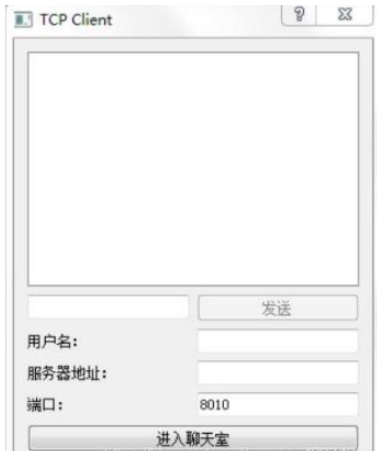
最后,同時運行服務器和客戶端程序,運行結果如下圖所示,這里演示的是系統中登錄了兩 個用戶的狀態。



以上就是“QT基于TCP如何實現網絡聊天室程序”這篇文章的所有內容,感謝各位的閱讀!相信大家閱讀完這篇文章都有很大的收獲,小編每天都會為大家更新不同的知識,如果還想學習更多的知識,請關注億速云行業資訊頻道。
免責聲明:本站發布的內容(圖片、視頻和文字)以原創、轉載和分享為主,文章觀點不代表本網站立場,如果涉及侵權請聯系站長郵箱:is@yisu.com進行舉報,并提供相關證據,一經查實,將立刻刪除涉嫌侵權內容。